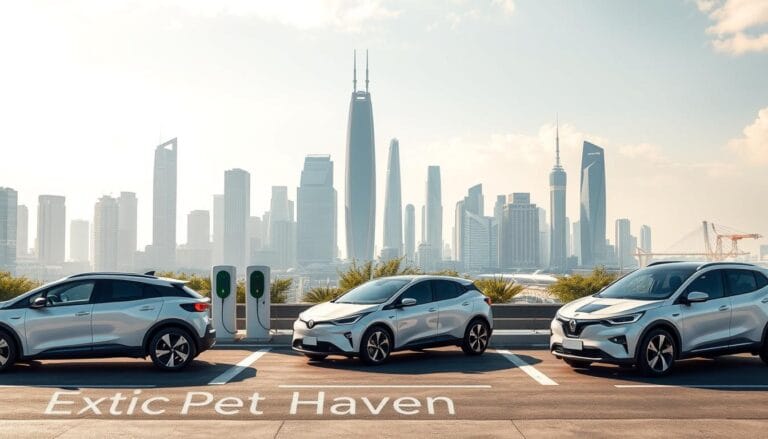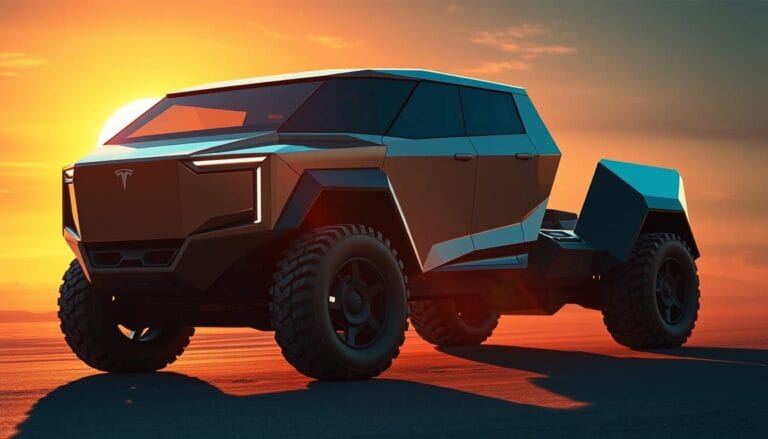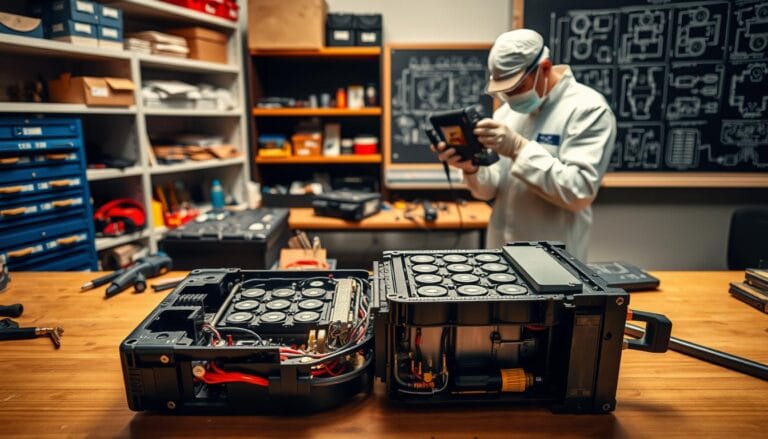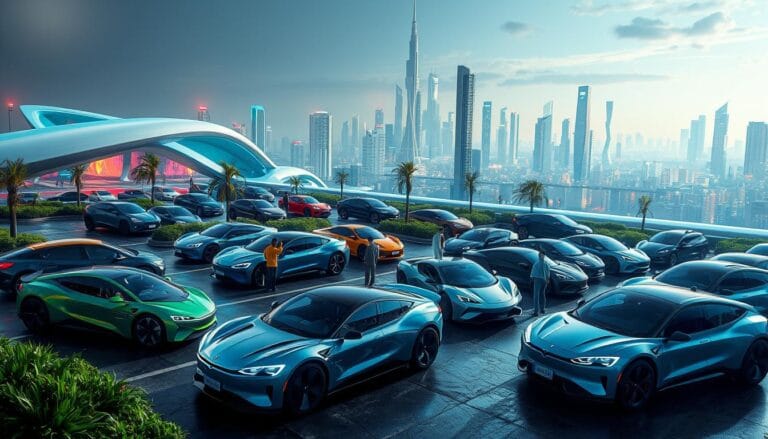Sustainable Transportation News: The Latest EV Updates for 2025
The electric vehicle revolution is changing our roads. 2025 is set to be a key year for green transport. Battery-electric vehicles are now over 9% of new cars, marking a big change in car history.
This change isn’t just about new tech. It’s about how we travel, connect, and care for our planet. Electric vehicles are no longer just for a few. With 94% of current owners wanting another, the trend is clear.
The world of green transport is growing fast. New battery tech and more charging spots are making EVs more appealing. Whether you love tech or care about the planet, 2025’s EV market has something special for you.
Table of Contents
The Shift Toward Electric Vehicles in 2025
The car world is changing fast as Electric Vehicles (EVs) become more popular. In 2025, we’re at a key moment in car history. New tech and designs are changing how we move around.
What This Means for You as a Driver
Your driving days are changing. Electric cars are now the top choice for many. Here are some important points:
- Nearly one in five cars sold worldwide is now electric
- EV ownership costs are becoming more competitive
- Charging infrastructure continues to expand dramatically
Key Trends to Watch
The EV market is growing fast, with some amazing stats:
| Market Metric | 2025 Projection |
|---|---|
| Global EV Market Value | $418.2 billion |
| Expected Market Size by 2050 | $72,798 billion |
| U.S. EV Market Share | 11% |
Impact on Fuel Prices
The rise of Low-Emission Fuels is changing the economy. As more people choose electric cars, traditional fuel markets are feeling the impact. Your fuel costs could see substantial reductions with the growing use of electric tech.
“The future of transportation is electric, and that future is now.” – EV Industry Expert
Drivers can look forward to more innovation, affordable choices, and a better charging network. Electric Vehicles are becoming the new norm in personal transport.
Upcoming Events Influencing Sustainable Transportation
The world of green transportation is changing fast in 2025. Big events are coming that will change how we move around. We’ll see new electric car shows and bigger networks, helping us switch to cleaner ways to travel.
Tesla Supercharger Access in June 2025
Tesla is making a big change in how we travel. In June 2025, they will let non-Tesla cars use their Superchargers. This will change how we charge our cars all over the US.
- Expanded charging network covering major metropolitan areas
- Compatibility with multiple EV brands
- Reduced charging times and increased station availability
KGM Musso EV Launch: What to Expect
The KGM Musso EV is coming, and it’s going to be big. It will bring new electric car tech to those who want to save money. This car will make green travel cheaper and easier for everyone.
Other Noteworthy EV Showcases
2025 is going to be a great year for electric car fans. The Fresno International Transportation Innovations 2025 S.T.E.P. Summit will show us the future of green travel. It will feature:
- Vehicle exhibitions showing off the latest EV tech
- Panel talks on energy and transport infrastructure
- Speeches from top industry leaders
The future of transportation is electric, connected, and increasingly sustainable.
Government Policies Supporting EV Adoption
The world of Electric Vehicles is changing fast thanks to government policies. Leaders are making plans to help us move towards cleaner transport. They want to make electric cars easier to get and more affordable.
Understanding the New Incentives
The U.S. government has set aside $19 billion to boost electric car use. This money will help in several key areas:
- Building more charging stations
- Buying electric buses
- Creating jobs in clean energy
“Our goal is to make electric cars a smart choice for all Americans,” says a top transportation official.
How These Policies Affect Your Purchase
Government help can cut down the cost of Electric Vehicles. EV owners might save:
- $700 a year on fuel
- $330 on maintenance
- Up to $7,500 in tax credits
The Role of State Incentives
State programs are key in promoting Electric Vehicles. Places like California and New York are working on special plans. They aim to support clean transport.
These local efforts want to create many clean-energy jobs. They also aim to build a fair economy for electric car infrastructure.
Innovations in EV Technology
The world of electric vehicles is changing fast. New technologies are changing how we see Electric Vehicles. They are making cars better and smarter.
Breakthroughs in Battery Life
Battery tech is getting a big boost. New discoveries are making batteries better and more powerful:
- SK On plans to deliver nearly 100GWh of high-performance batteries from 2028 through 2033
- 90% of EV makers think better batteries will change car designs
- New battery tech means longer drives and quicker charges
Advancements in Charging Infrastructure
Charging tech is getting smarter and more common. Here’s what’s happening:
- 74% of car makers say charging is a big challenge
- Companies are spending a lot to grow charging networks
- Autonomous tech is working with smart charging systems
Software Updates Making EVs Smarter
Software is turning Electric Vehicles into smart cars. TCS has helped with over 500,000 EVs worldwide. This shows how fast tech is moving.
The future of transportation is not just electric—it’s intelligent.
Thanks to better batteries, charging, and software, Electric Vehicles are getting better. They are more fun, efficient, and easy to use than ever.
Sustainable Transportation Trends Beyond EVs
Electric vehicles are changing how we move, but they’re not the only game in town. Other cool ways to get around cities are popping up. These new options could change how we travel in big ways.
Micromobility is making cities more fun to get around. Sustainable Transportation News talks about some big changes in urban travel:
- E-bikes and electric scooters are great for short trips
- Ride-sharing services are using greener cars
- Biking paths are growing in big cities
The Rise of E-Bikes and Scooters
More people are choosing small, green vehicles for their daily rides. A 2021 McKinsey study found 70% of folks are into biking, e-biking, or scooting to work. Cities with safe bike lanes see a big jump in riders, up to 171%.
“Urban mobility is no longer just about cars – it’s about creating diverse, sustainable transportation ecosystems.”
Public Transportation Upgrades
Cities are spending big on better public transit. They’re adding smart tech to make Ride-Sharing Services better. Now, finding your way and tracking buses is easier than ever.
The Future of Autonomous Vehicles
Autonomous cars are getting closer to reality. They could make our cities smarter, greener, and more efficient. With better Biking Infrastructure and self-driving tech, our travel options are about to get a lot better.
Challenges Facing the EV Market
The electric vehicle market is growing, but it faces many challenges. These challenges affect manufacturers, consumers, and those in green logistics. It’s important to find new ways to solve these problems.

Supply Chain Complexities
Electric vehicles have big supply chain issues. The main problems are:
- Not enough raw materials for batteries
- Shortages of global semiconductors
- Higher production costs
Consumer Education Strategies
Many people don’t understand electric vehicles well. We need to teach them more about:
- The total cost of owning an EV
- The long-term savings
- The environmental benefits
Addressing Range Anxiety
Range anxiety stops many from buying electric vehicles. But, there are good solutions:
- Better battery tech for longer drives
- More charging spots across the country
- Quicker charging options
By 2024, the UK expects 1.1 million full electric vehicles on its roads, representing a 13% market increase.
The green logistics field is finding new ways to help. They aim to make electric vehicles more appealing and accessible to everyone.
Comparing Different EV Models
The electric vehicle market is growing fast, giving drivers many choices for green travel. Choosing the right EV means looking at performance, cost, and what you need.
Finding the right EV can be tough, but knowing your options helps you make a smart choice.
Best EVs for Range and Performance
Top EVs show great skills:
- Rivian R1T: Saves a lot of greenhouse gases
- Lucid Air Pure: Very efficient
- Tesla Model 3: Low emissions all the time
- BMW i4: Good mix of performance and green living
Budget-Friendly Options in 2025
For those watching their wallet, there are great EVs:
- Hyundai Ioniq 6: Top mainstream EV with lower total ownership costs
- Chevrolet Bolt: Small design, less environmental harm
- Ford Mach-E: Good price with LFP battery tech
Electric vehicles can save owners over $18,000 across their lifecycle compared to traditional gasoline cars.
Luxury EVs to Consider
High-end EVs are leading in tech:
- Porsche Taycan: Great depreciation value
- Mercedes EQS SUV: Luxury with green design
- Audi e-tron GT: Electric luxury at its best
When picking an EV, think about more than just the price. Look at lifecycle costs, environmental effect, and what you need to drive.
The Environmental Impact of EVs
Electric vehicles are key to cutting down global carbon emissions. They promise a cleaner future, but their true impact is more complex. The story of Electric Vehicles is not just about cutting down on tailpipe emissions.
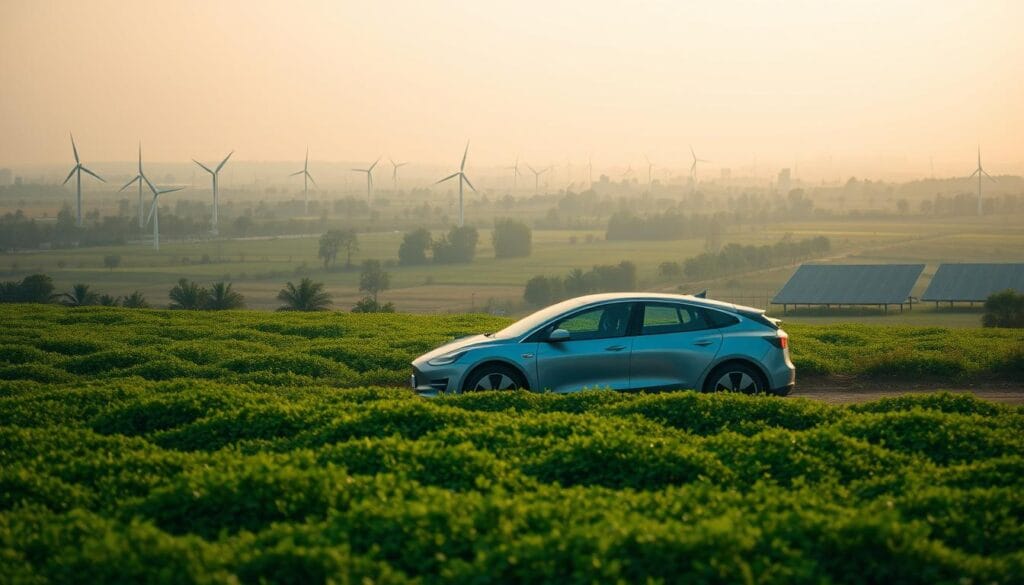
The environmental challenges of Electric Vehicles are complex and multifaceted. Let’s explore the key aspects of their ecological footprint:
- Mineral extraction for battery production creates significant environmental pressures
- Lithium and cobalt mining have substantial ecological implications
- The carbon intensity of electricity generation impacts overall emissions
Reducing Carbon Footprint with Electric Vehicles
Electric Vehicles can cut down carbon emissions a lot, if they run on renewable energy. The International Energy Agency says EVs need six times more minerals than gas cars. Your choice to drive an EV can help cut down greenhouse gas emissions.
Importance of Recycling EV Batteries
Battery recycling is key to making transportation sustainable. Here are some interesting facts about battery materials:
| Material | Usage in EV Batteries | Environmental Consideration |
|---|---|---|
| Lithium | 66% global production in 2020 | Intensive water consumption |
| Cobalt | Key battery component | Ethical mining challenges |
How Your Choices Matter
Your choices can lead to big changes in using Low-Emission Fuels. By picking Electric Vehicles and supporting green manufacturing, you help make transportation better for the planet.
Every electric vehicle represents a step towards reducing global carbon emissions.
The Economics of Going Electric
Electric vehicles offer big financial wins for today’s drivers. News keeps showing how switching to EVs can save money.
Total Cost of Ownership for EVs
Electric Vehicles are changing how we own cars. They last long and perform well. Studies show EVs can now match gas cars in lifespan, lasting up to 18.4 years and traveling 124,000 miles.
- Average BEV lifespan: 18.4 years
- Maximum travel distance: 124,000 miles
- 12% lower annual failure rate compared to traditional vehicles
Charging Costs vs. Gasoline Expenses
There’s more to saving money than just buying an EV. Electric Vehicles have lower running costs. They have fewer parts, which means less maintenance.
| Vehicle Type | Annual Maintenance Cost | Fuel/Charging Efficiency |
|---|---|---|
| Battery Electric Vehicle | Lower | Higher |
| Petrol Vehicle | Higher | Lower |
Resale Value Trends for Electric Vehicles
The market loves electric cars. 94% of EV owners want to buy another one. Brands like Tesla keep their value high over time.
Electric Vehicles represent not just a transportation choice, but a smart financial investment.
Future Predictions for Sustainable Transportation
The world of green transportation is changing fast. Autonomous driving and city planning are changing how we move. By 2030, big changes in transportation tech will alter your daily travel and city layout.
Electric and hydrogen cars will soon be common, thanks to sustainable transportation news. Hydrogen cars, like the Toyota Mirai, can go over 300 miles and refuel quickly. Cities are adding hydrogen buses and new transport ideas to cut down on pollution.
Autonomous driving will change city travel, with tech reaching level 7-8 by 2030. Digital twins will help cities plan better transport systems. Your travel will involve AI traffic control, smart prices, and connected mobility.
By 2030, electric, hydrogen, and self-driving tech will change how we get around. Cities will focus on green transport, making your daily trip better for the planet and tech.
What Experts Are Saying About 2030
Experts say we’re in for a mobility revolution. Hydrogen and electric cars will lead the way. AI, smart roads, and new engines will change city travel.
How These Changes Will Affect You
You’ll see greener, smarter, and more efficient transport options. Your future commute will be cleaner, smarter, and more connected.
A Glimpse into the Next Decade
The next ten years will bring a green, tech-focused transport world. From hydrogen trucks to self-driving cars, your travel will see a big change.


